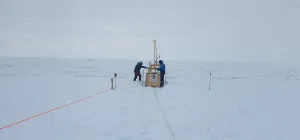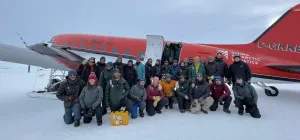"To the Antarctic" Exhibition at MAS Closes but Leaves Behind Great Memories and Many Successes
The “To the Antarctic” Exhibition at MAS /museum in Antwerp, which ran from June 21st until November 3rd, was very popular among the general public, receiving more than 45,000 visitors during its more than four-month run.
The exhibition featured Belgium’s history in Antarctic exploration and research, starting with the extraordinary overwintering of Adrien de Gerlache and his crew on the Belgica ship in 1897-1899. Visitors were completely immersed in the daily lives of all crew members onboard and learned along the way about the many scientific findings from the exhibition, the Antarctic environment, and particularities of the Antarctic Peninsula.
Following the chronology of De Gerlache’s endeavour, visitors learned about Belgium’s research expeditions in Antarctica in the 1950s and 1960s, during which Belgium’s first Antarctic research base, the King Baudouin station, was constructed.
From the past to the present
A scale model of the Princess Elisabeth Antarctica (PEA) station welcomed the visitors into the contemporary part of the exhibition, which was largely developed by the IPF for MAS. Visitors enjoyed the beauty of Antarctic landscapes on a large screen, and explored a topic of their choice (ocean, air, space, earth, ice, life) on wall-mounted touch-screens that explained all aspects of research currently going on in Antarctica, much of which is taking place at Princess Elisabeth Antarctica. Before leaving, visitors were invited to reflect on the presence and activities of humans in Antarctica, and were treated to an art installation by Dutch artist Esther Kokmeijer called Terra Nullius, which drew attention to Antarctica's unique protected geopolitical status and uncertain future.
“The International Polar Foundation has a long history in education, outreach and awareness-rising about the polar regions and their important role in the global climate,” commented Dr Mieke Sterken, who was in charge of the contemporary contributions to the exhibition. “We have organised exhibitions about Antarctic science, Arctic climate change and environment-related topics.”
The Belgian zero-emission Princess Elisabeth Antarctica station is a good example of how polar research can be made more environmentally friendly, and offers a wide range of possibilities in terms of scientific research. It was successfully used as a hook to get people interested in learning more about the polar regions. We are very pleased that MAS has chosen us as a partner to help develop the recent past and contemporary parts of the exhibition."
The MAS gift shop formed a creative extension of the exhibition, showcasing a large LEGO scale model of the station, built by LEGO enthusiast Daniel Vermeir. The IPF offered books, gadgets and postcards with photos of the station, beautiful Antarctic landscapes, and the incredible fauna of the region.
Broad appeal
We received a lot of positive feedback from visitors, who said the exhibition felt like discovering a new continent by themselves. They came for both the epic story of the Belgica and to learn about Antarctica as a whole. They were very touched by the personal stories of the Belgica crew, whose diary excerpts were displayed throughout the exhibit.
“You have the gift of explaining difficult things in a very easy to understand and enthusiastic way, it was a true pleasure to visit the exhibition and I'm happy I went," one visitor said.
The exhibition also enjoyed media coverage in local and national Belgian media outlets, including on VRT news and radio, which did a live on air session from the exhibition, as well as the Brussels Times and many other publications and outlets.
Visitors can still submit their feedback or test their knowledge through a quiz (in Dutch) via via this link: https://www.ipf-education.org/mas
Now the attention shifts to Antarctica, where the 2024-25 BELgian Antarctic research Expedition (BELARE) has just begun.
Download





















